
Cold frames vs. quick hoops
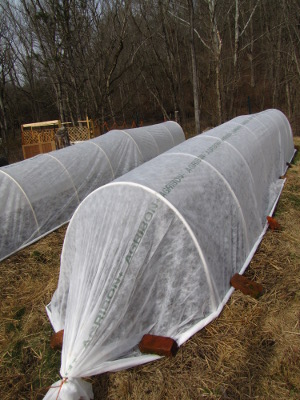 While
planting lettuce, onions, and spinach yesterday, I pondered the pros
and cons of quick
hoops versus cold frames. I'm not going to have
any side by side comparisons this year, but I have started noticing
that each system works a bit differently. Here are the main
factors to consider when choosing whether to build a quick hoop or a
cold frame:
While
planting lettuce, onions, and spinach yesterday, I pondered the pros
and cons of quick
hoops versus cold frames. I'm not going to have
any side by side comparisons this year, but I have started noticing
that each system works a bit differently. Here are the main
factors to consider when choosing whether to build a quick hoop or a
cold frame:
- Light penetration --- This is where I suspect that quick hoops win. Cold frames have wooden walls that shade a relatively large area on the south side of the bed, and in early spring I've noticed that lettuce just won't germinate in that cold spot. Quick hoops don't create any shady areas, and so far I've seen no cold spots that restrict germination.
- Heat capture --- I have
no data here, but my gut says that the lower profile of cold frames
would hold the day's heat closer to the plants. However, Eliot
Coleman's experiments suggest that light penetration is more important
than heat capture when growing cold weather crops, so quick hoops'
lower ability to capture heat might not matter.
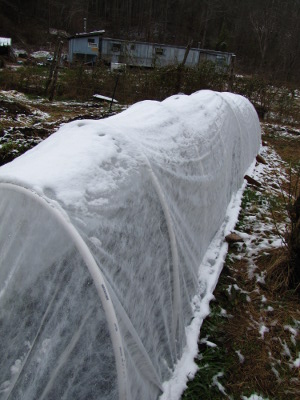 Water penetration ---
Here quick hoops lose. The flat top of cold frames lets water
pool on the row cover fabric just long enough to drip down through and
water your bed, but water mostly runs off the quick hoop. I was
surprised to see dry spots inside our quick hoops this week despite
about eight
inches of rain in as many days.
Water penetration ---
Here quick hoops lose. The flat top of cold frames lets water
pool on the row cover fabric just long enough to drip down through and
water your bed, but water mostly runs off the quick hoop. I was
surprised to see dry spots inside our quick hoops this week despite
about eight
inches of rain in as many days.
- Snow load --- The same structural features that make water slide off quick hoops makes snow slide off as well, so I suspect quick hoops would stand up much better under heavy snow conditions than cold frames do.
- Wind --- The higher
profile of quick hoops catches wind much more than our cold frames
do. We haven't had any more major trouble since I added the rebar
to the sides, but we also don't live in a very windy climate. If
you live in a treeless area, you might be better off with cold frames.
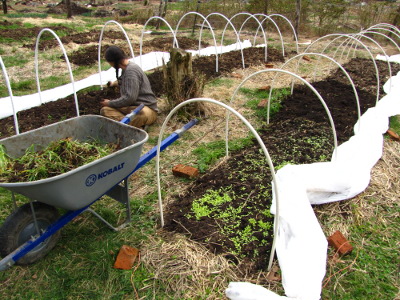 Ease of opening --- This
is a toss-up, but I think that cold frames win. It takes me about
five minutes to carefully unroll the rebar and take the row cover
fabric off the quick hoops, although if I just want to peek in I can
simply untie one end and stick my head under the fabric. My cold
frames are usually much
easier to get into. That said, I suspect that we can come up with
a more accessible quick hoop as we play around with the design.
Ease of opening --- This
is a toss-up, but I think that cold frames win. It takes me about
five minutes to carefully unroll the rebar and take the row cover
fabric off the quick hoops, although if I just want to peek in I can
simply untie one end and stick my head under the fabric. My cold
frames are usually much
easier to get into. That said, I suspect that we can come up with
a more accessible quick hoop as we play around with the design.
- Cost --- If you have old
lumber lying around like we do, cold frames are a big winner since they
only cost as much as the fabric and screws. On the other hand, if
you're buying the materials new, I estimate that our quick hoop costs
29 cents per square foot (if you use the cheap PVC rather than the
hot/cold version) versus 64 cents per square foot for a cold frame (if
you use untreated 2X10s).
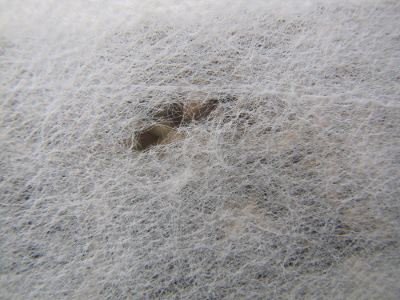 Longevity of fabric ---
After the initial construction, the only regular cost for either system
is replacing tattered row cover fabric. I've noticed that the
tautness of the quick hoop fabric makes it very
easy to punch your fingers through, and the rebar tries to snag and
tear holes as well. However, our animals don't think quick hoops
look like a fun thing to jump on, which is the fastest way to lose row
cover fabric, so we might actually get a bit more longevity out of our
quick hoop fabric than out of our cold frames.
Longevity of fabric ---
After the initial construction, the only regular cost for either system
is replacing tattered row cover fabric. I've noticed that the
tautness of the quick hoop fabric makes it very
easy to punch your fingers through, and the rebar tries to snag and
tear holes as well. However, our animals don't think quick hoops
look like a fun thing to jump on, which is the fastest way to lose row
cover fabric, so we might actually get a bit more longevity out of our
quick hoop fabric than out of our cold frames.
- Modularity --- Our raised
beds aren't all the same width or length, so I've found it difficult to
move cold frames from bed to bed. With my rotten, salvaged
lumber, cold frames also tend to fall apart when I move them.
Quick hoops are much more modular since you can just drive in your
rebar stakes at the edges of the bed and cover irregularly shaped beds,
using the same raw materials in different years to protect beds with
somewhat different dimensions.
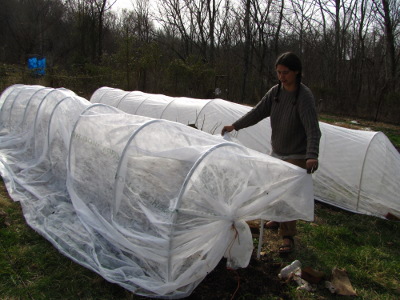 Speed of contstruction
--- Once we knew what we were doing, it took about two hours of my time
and half an hour of Mark's time to make a 23 foot long quick
hoop. Cold frames require two people for more of the process, but
probably take about the same number of man-hours.
Speed of contstruction
--- Once we knew what we were doing, it took about two hours of my time
and half an hour of Mark's time to make a 23 foot long quick
hoop. Cold frames require two people for more of the process, but
probably take about the same number of man-hours.
- Ease of storage --- Quick hoops win big here. During the summer when I don't need our cold frames, they're leaning up against a fence or wall, which creates a weedy spot that's hard to mow around. Quick hoops disassemble into a few long poles and a bit of fabric, so they'll be easier to fit into storage.
- Aesthetics --- Our cold
frames are pretty enough, but there's just something striking about the
domed quick hoops that tempts me out into the garden.
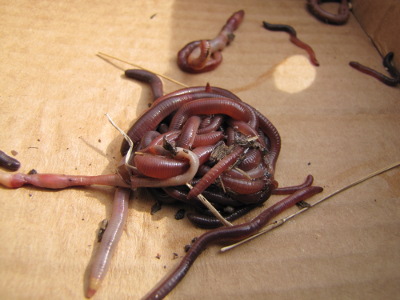 Worm collection --- I don't know if
this is a positive or a negative, but our quick hoop seems to collect
earthworms in the rolled up fabric on the edges. I pulled this
handful of worms out as I opened up the quick hoop Tuesday, and the
chickens were very appreciative.
Worm collection --- I don't know if
this is a positive or a negative, but our quick hoop seems to collect
earthworms in the rolled up fabric on the edges. I pulled this
handful of worms out as I opened up the quick hoop Tuesday, and the
chickens were very appreciative.
Overall, my gut feeling
is that quick hoops are the winner, although
I'd love to figure out a way to make them easier to get into. I'm
pondering making long, skinny sandbags out of old dogfood sacks that
can be laid along the entire edge of the structure. Stay tuned
for more details!
Want more in-depth information? Browse through our books.
Or explore more posts by date or by subject.
About us: Anna Hess and Mark Hamilton spent over a decade living self-sufficiently in the mountains of Virginia before moving north to start over from scratch in the foothills of Ohio. They've experimented with permaculture, no-till gardening, trailersteading, home-based microbusinesses and much more, writing about their adventures in both blogs and books.
Want to be notified when new comments are posted on this page? Click on the RSS button after you add a comment to subscribe to the comment feed, or simply check the box beside "email replies to me" while writing your comment.
RSS
Quick hoop sand bags
I like the idea of using dog food bags for homemade sand tubes. I have been collecting our dog food bags for several years now and I have quite a few of them. The woven tarp like material that they are made of would make a very strong sand tube for constructing a small building with a satellite dish for the roof but I haven't come up with an easy way of making two sand tubes from one bag. I thought it might be possible to sew the bag down the center twice and then cut through the center with scissors but I haven't tried it yet. Have you thought about how you wanted to do it?
Comment by
zimmy
— Thu Mar 10 12:56:08 2011
- Remove comment
Dogfood sand bags
Those dogfood bags really look too useful to throw away, don't they? Mark thinks I'm nuts, but I was thinking of something really quick and dirty --- using duct tape to tape two sides of the bag together, effectively cutting it in half without cutting, then filling up one of the halves with sand.
Comment by
anna
— Thu Mar 10 13:18:26 2011
- Remove comment
Tears in row cover
Would super glue work to repair tears? I'm researching into using row covers and notice tearing is a number one factor.
Comment by
Cheryl
— Tue Sep 13 22:32:54 2011
- Remove comment
Tears
You're right --- I love row cover fabric until it tears, then wish there was a better solution. I haven't tried superglue, but it'd be worth a shot. I sometimes sew the tears gently back together with a running stitch, but that puts more stress on other places in the fabric since I inevitably overlap a bit of fabric to mend it. I've tried patches but they take forever... 

Comment by
anna
— Wed Sep 14 08:01:38 2011
- Remove comment
Add a comment
